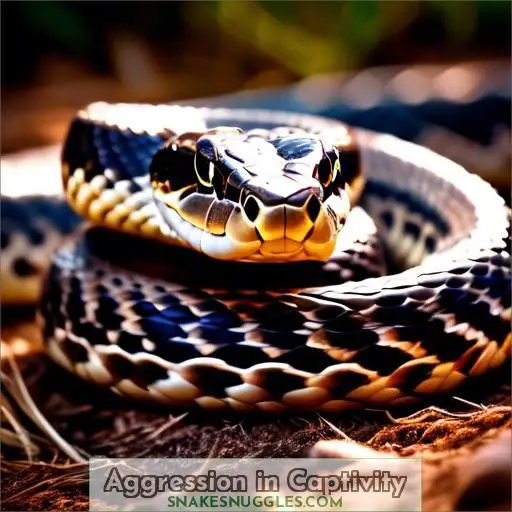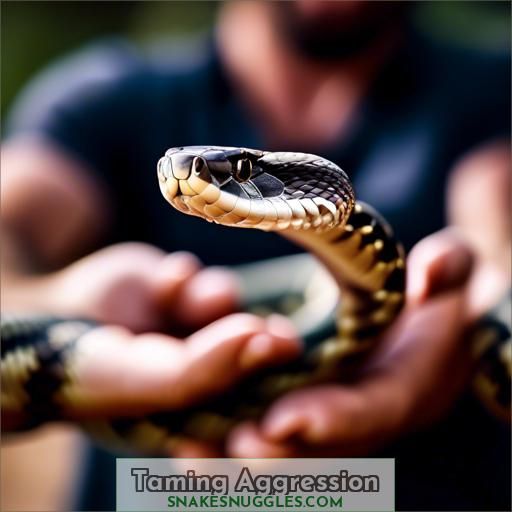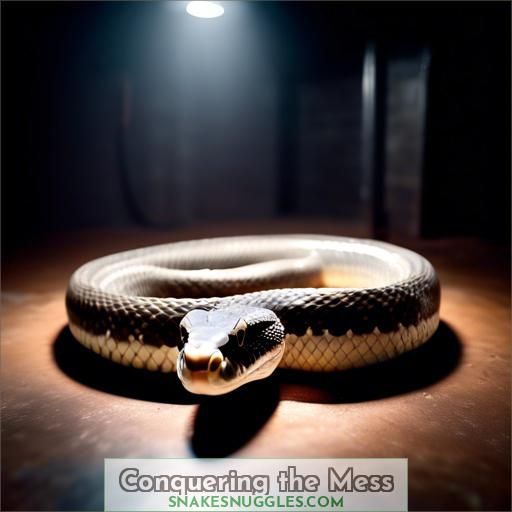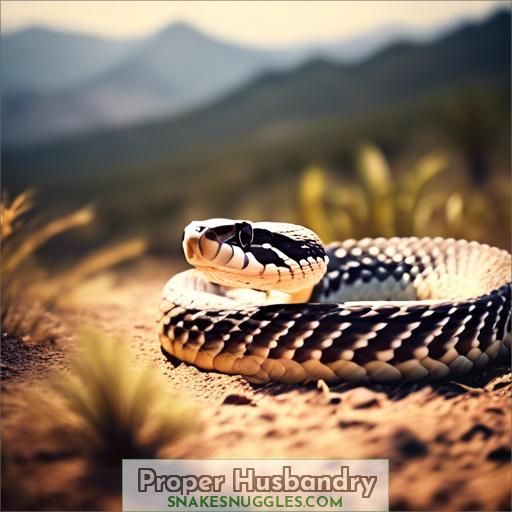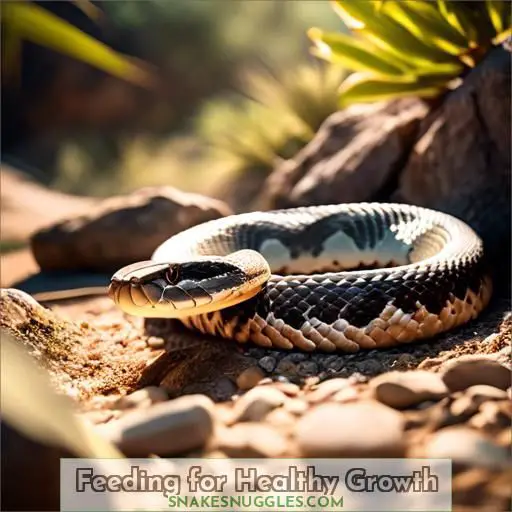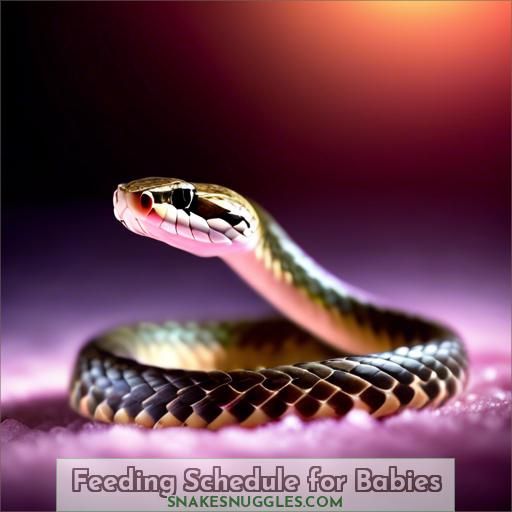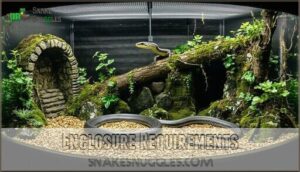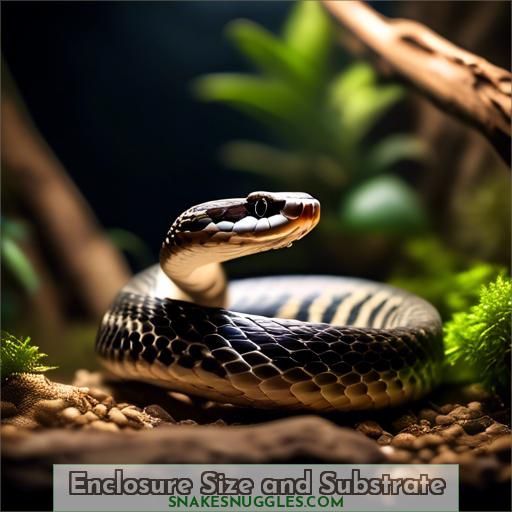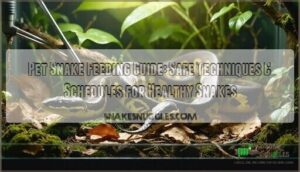This site is supported by our readers. We may earn a commission, at no cost to you, if you purchase through links.

You’re beginning on caring for a bull snake, where understanding their unique needs is essential.
Taming aggression involves frequent handling from a young age, using gentle movements, positive reinforcement for calm behavior, and correcting overly enthusiastic feeding responses.
Managing the mess is attainable through proper husbandry – using an air purifier, daily spot cleaning, bi-weekly thorough cleaning, and bi-monthly warm water soaking of water dishes.
Feeding for healthy growth requires a weekly feeding schedule or several smaller meals, offering a variety of food options around 1.5 times the snake’s widest body part.
Monitor body condition regularly.
Explore further to uncover the secrets of creating an ideal bull snake care sheet.
Table Of Contents
Key Takeaways
- Frequent handling from a young age helps tame aggression in bull snakes.
- Proper husbandry involves using air purifiers, daily spot cleaning, bi-weekly thorough cleaning, and bi-monthly warm water soaking of water dishes.
- A weekly feeding schedule or several smaller meals, offering a variety of food options around 1.5 times the snake’s widest body part, is essential for healthy growth.
- Understanding the snake’s natural behaviors and implementing proper handling techniques can manage aggression in captivity.
Aggression in Captivity
Bull snakes, while known for their hissing and defensive behaviors, are often mischaracterized as aggressive. In reality, their aggression is often a result of inappropriate handling or fear. To manage aggression in captivity, it’s essential to understand their natural behaviors and implement proper handling techniques.
- Handling Frequency: Frequent handling when young can improve tameness. However, avoid handling after or before feeding as this can stress the snake.
- Patience and Consistency: Bull snakes need time to adjust to their environment and their keepers. Be patient and consistent in your handling and care.
- Correcting Feeding Responses: Overly aggressive feeding responses can be corrected with proper handling. Make sure that food is handled gently and the snake isn’t startled during feeding.
Taming Aggression
You should handle bullsnakes frequently from a young age to tame their aggressive tendencies. Regular, patient handling desensitizes them to human interaction, reducing defensive behaviors like hissing and striking.
Consistency is essential when taming aggressive feeders. Correcting overly enthusiastic striking at prey items by tapping their snouts and removing the food until they remain calm during feedings can reshape their feeding responses over time.
Handling Frequency
Bull snakes are known for their aggressive behavior, but this is often due to inappropriate handling.
To tame their aggression, it’s essential to handle them frequently when they’re young.
This helps them become accustomed to human presence and reduces their fear.
However, avoid handling them immediately after feeding or before feeding, as this can trigger defensive behaviors.
Also, be sure to remove any shed skin promptly and check for completeness to prevent irritation.
Patience and Consistency
Taming a bull snake’s aggression is like learning a dance; it takes two to tango. Here’s your four-step guide:
- Employ calming techniques, like slow movements, to build trust without startling your slithery partner.
- Use desensitization methods; expose them gradually to handling, turning hisses into yawns.
- Positive reinforcement goes a long way; reward calm behavior to reinforce the peace.
- Remember, patience and consistency are your rhythm; keep the beat, and you’ll both groove in harmony.
Correcting Feeding Responses
To rectify feeding response biting in bullsnakes, it’s imperative to discern the underlying cause and implement targeted strategies. The feeding response is frequently a consequence of the snake correlating your hand with sustenance. To mitigate this, you can utilize a snake hook to distinguish between manipulation and nourishment. The hook can communicate to the serpent to transition from feeding posture to manipulation or flight posture. Furthermore, you can employ target training to impart to your serpent when to anticipate food, and to move towards an object (the target). This approach can assist in preventing feeding response bites when extricating the snake from its enclosure.
When feeding, ascertain that you present the prey item on a paper plate to maintain it devoid of substrate, as consolidation can engender complications. It’s also prudent to permit the serpent to repose for a minimum of 24 to 48 hours subsequent to feeding prior to manipulating anew, and to avoid manipulation directly preceding feeding, as it can engender stress that impacts the serpent’s desire in the prey item.
To preclude feeding response bites, verify that the serpent isn’t famished when you manipulate it. Present the prey item on a paper plate to maintain it devoid of substrate, and avoid manipulating the serpent subsequent to or preceding feeding. If the serpent is in feeding mode, it may strike at anything that moves, encompassing your hand. This behavior is customary, but it can be managed by comprehending the serpent’s necessities and adjusting your manipulation techniques as appropriate.
Conquering the Mess
Bull snakes are known for their messiness, but with proper husbandry, you can keep their enclosure clean and healthy. Here’s a three-step guide to help you conquer the mess:
- Air Purifiers: Invest in an air purifier to remove scent particles and improve air quality. This will help reduce the smell of waste and make your enclosure more pleasant for you and your snake.
- Daily Cage Cleaning: Spot clean the enclosure daily to remove waste and maintain a hygienic environment. This includes cleaning the water bowl and removing any uneaten food.
- Deep Cleaning: Perform a deep cleaning every two weeks. This involves removing everything from the enclosure, cleaning all accessories with a reptile-safe disinfectant, and replacing the substrate.
Proper Husbandry
For proper husbandry of bull snakes, you’ll need an air purifier to remove odors and improve air quality. Daily spot cleaning along with deep cleaning using a reptile-safe disinfectant every two weeks is essential to maintain a hygienic enclosure. Bi-monthly soaking and scrubbing of water dishes helps prevent bacterial buildup that could lead to health issues.
Air Purifiers
Regarding your bullsnake’s dwelling, consider air purifiers as the unsung saviors of odor management. They’re like stealthy agents, discreetly neutralizing scent particles, guaranteeing superior air quality for both you and your serpentine companion. Here’s a concise overview of their advantages:
| Health Benefits | Pet Safety |
|---|---|
| Lessens allergens | Non-intrusive |
| Enhances air purity | Noiseless operation |
| Neutralizes odors | Harmless to snakes |
Daily Cage Cleaning
Bull snakes, like any other reptile, require regular cage cleaning to maintain a healthy and hygienic environment. Daily cleaning is essential for removing waste, uneaten food, and any spilled water. Here’s how you can keep your bull snake’s habitat clean:
- Waste Removal: Every day, remove any feces, urate, or dirty substrate from the cage. This helps prevent the buildup of bacteria and keeps the environment clean for your snake.
- Water Bowl Cleaning: Wash your snake’s water bowl daily using a scrub brush, hot water, and an unscented dish soap. If you’re feeling ambitious, use a hard-bristled toothbrush to clean the cracks and crevices.
- Substrate Maintenance: Keep the substrate clean by removing any old or damp bedding. Regularly replace it with fresh, clean substrate to guarantee a healthy environment for your snake.
Deep Cleaning
Deep cleaning is an essential part of maintaining a healthy environment for your bull snake.
Aim to deep clean your snake’s enclosure every two weeks using Healthy Habitat cleaner.
This will help remove any built-up waste and guarantee your snake’s living space remains clean and hygienic.
Additionally, don’t forget to wash the water dishes every two weeks to maintain the utmost cleanliness.
Bi-monthly Hot Water Soaking
Regular hot water soaking is essential for preserving a clean and wholesome environment for your bullsnake.
This entails immersing the water dish in hot water to eliminate bacteria and sterilize it.
Moreover, the water dish should be cleaned in a dishwasher every other week to remove any lingering food particles or odors.
The water bowl’s size is also significant, as it should be spacious enough for your snake to submerge itself entirely for soaking.
Humidity regulation is equally important, as excessive humidity can foster fungal infections.
By adopting these measures into your care routine, you can safeguard your bullsnake’s well-being and contentment.
Feeding for Healthy Growth
Nourishment is a vital aspect of bullsnake care. These snakes have insatiable appetites and develop rapidly. To promote healthy growth, adhere to these guidelines:
- Feeding Frequency: Nourish once a week or provide several smaller food items. For hatchlings, nourish every 4-5 days. For adults, nourish once a week or fortnightly.
- Food Variety: Offer an array of food options, including rodents, rabbits, squirrels, chipmunks, small birds, and bird eggs.
- Prey Size: Ensure the food is 1.5 times the widest part of the snake’s body. This prevents overfeeding and corpulence.
- Obesity Prevention: Avoid excessive feeding and ensure the snake isn’t overweight. This can lead to health ailments.
- Body Condition Monitoring: Regularly assess the snake’s body condition. This can be done by palpating the snake’s body and observing its general health.
Feeding Schedule for Babies
You’ll want to start newborn bull snakes on small prey like pink mice, feeding 2-3 of them every 4 days for the first month. Gradually increase the size of the prey items, moving to fuzzy mice, then hopper mice, and eventually adult mice or small rats as the snake grows larger.
Gradual Increase in Food Size
As your bullsnake sheds its baby scales, so should it shed its diet of pink mice. You’ll want to gradually introduce larger food options, ensuring the prey size is about 1.5 times the girth of your growing serpent. Keep an eye on feeding frequency to maintain a healthy body condition, steering clear of overfeeding.
| Age | Prey Size |
|---|---|
| Newborn | Pink mice |
| 1 month | Fuzzy mice |
| 2-3 months | Hopper mice |
| 4+ months | Small rats |
Feeding Frequency for Adults
- Stick to a consistent feeding schedule: Feed your bullsnake once a week, providing it with a balanced diet of rodents, rabbits, squirrels, and other small animals.
- Adjust food size based on the snake’s girth: Make sure that the prey item is 1.5 times the largest part of the snake’s body.
- Avoid overfeeding: Don’t feed your bullsnake more than it can consume in one sitting to prevent obesity.
- Monitor body condition: Keep an eye on your bullsnake’s overall health and adjust its feeding schedule accordingly.
Lighting and Temperature
As we explore the care of bull snakes in more depth, let’s examine the significance of lighting and temperature within their enclosures. Foremost, it’s essential to uphold appropriate incubator temperatures, as neglecting this can result in metabolic bone disease. Moreover, these temperatures can also initiate brumation, a stage of inactivity and diminished metabolism.
The amount of moisture within the substrate of the enclosure should be closely monitored, as excessive moisture can adversely affect the snake’s well-being. Ventilation of the enclosure is another vital element, as it guarantees adequate air circulation and prevents the accumulation of hazardous gases.
Regarding lighting, bull snakes don’t require any specific lighting or UV illumination. However, proper digestion necessitates warm temperatures, ideally in the upper 70s Fahrenheit at the warmest point and lower 70s at the coolest point. Humidity isn’t a critical factor, but misting during shedding can facilitate the shedding process.
Ideal Temperature Range
You’ll want to maintain temperatures in the ideal range of 75-80°F for proper digestion. Humidity isn’t critical, but maintaining 30-40% with a shallow water bowl allows for easy shedding; during shed cycles, bump humidity to 40-50%. A photoperiod replicating natural day/night cycles of 12 hours light and 12 hours dark is essential for overall health and behavior.
Proper Digestion
To guarantee appropriate digestion in your bullsnake, it’s imperative to maintain the optimal temperature range.
The snake’s metabolic rates and bodily processes are affected by temperature, and digestion is no different.
Warm temperatures are essential for digestion, as they assist the snake in producing digestive enzymes and breaking down food effectively.
Consequently, it’s recommended to keep the hotspot temperature in the high 70s Fahrenheit, while the cool end should be in the low 70s.
This temperature range allows for proper digestion and ensures that the snake’s metabolic rates are optimized.
Humidity Requirements
Moisture is essential for bullsnakes, particularly during molting. A moisture level of 30-40% is optimal, with a slight increase to 40-50% during molting. This aids in preventing breathing problems, dehydration worries, and mites and ticks. Bedding choices vary, but aspen shavings, cypress mulch, or ground walnut husks are commonly used. Adequate moisture regulation guarantees a healthy and content bullsnake.
Photoperiod
Photoperiod is fundamental for preserving the health and well-being of your bullsnake. A photoperiod is basically the day and night cycle, which is significant for every animal, including your bullsnake. In the wild, bullsnakes are primarily diurnal, meaning they’re active during the day, but they can become nocturnal in warmer months. In captivity, you can duplicate this natural cycle by providing a 12-hour light period and a 12-hour dark period. This can be achieved using a light set on a timer in your snake’s enclosure.
Light intensity, duration, and color spectrum are all factors to contemplate when setting up your bullsnake’s photoperiod. UV exposure can also play a role in your snake’s health, as it can influence hormone production and mood. While it’s not a pressing necessity like for some other reptiles, providing UV light can enhance your snake’s overall well-being.
Enclosure Requirements
Bullsnakes, akin to numerous other reptiles, necessitate precise enclosure conditions to flourish in captivity. These conditions encompass enclosure dimensions, hide positioning, ventilation requirements, and safety precautions**.
Enclosure Dimensions:
The enclosure must be sufficiently spacious to accommodate the serpent’s expanding size. For neonates, a 10-gallon aquarium is appropriate up to approximately 30 inches in length. For most matured specimens, a 4′ x 2′ x 2′ dimension serves well. The height holds lesser significance, as these serpents are predominantly terrestrial, yet they value some opportunities for climbing.
Hide Placement:
Hides assume paramount importance for security and well-being. They should be situated at both elevated and cooler portions of the enclosure to instill a sense of security and comfort for the snake.
Ventilation Requirements:
Bullsnakes necessitate ample ventilation for wholesome airflow. Enclosures adorned with mesh tops or lateral vents are recommended for appropriate air circulation.
Safety Precautions:
These serpents possess considerable strength and can effortlessly rearrange and topple insecure objects within their enclosure. It’s imperative to anchor any climbing structures or embellishments to avert accidents.
Decor Options:
Bullsnakes derive pleasure from having a substrate to burrow into. Aspen shavings, cypress mulch, and pulverized walnut shells constitute common substrates that facilitate burrowing for the captive. Furthermore, naturalistic adornments such as logs, boulders, and flora can be incorporated to generate a more stimulating environment.
Enclosure Size and Substrate
Setting Up a Bullsnake Enclosure: Essential Considerations
Size and substrate are key factors in a bullsnake’s enclosure. Here are three important points to keep in mind:
-
Habitat Selection: Bullsnakes are active and powerful, so they need a spacious enclosure that allows them to move freely. A rule of thumb is to provide 66% x 33% of the snake’s length for the vivarium dimensions. For example, a 10-gallon aquarium is appropriate for newborns up to 30 inches in length, while a 4′ x 2′ x 2′ size is suitable for most adults.
-
Natural Displays: To create a more realistic environment, use a substrate that allows the snake to burrow, such as aspen shavings, cypress mulch, or ground walnut husks. These materials not only provide a more natural look but also allow the snake to express its natural behaviors.
-
Hide Box Placement: Hide boxes are essential for the snake’s safety and health. Place them on both the warm and cool ends of the enclosure to provide the snake with a variety of habitats.
Frequently Asked Questions (FAQs)
How often should I clean my bullsnake’s enclosure?
You’ll want to do a daily spot clean and full enclosure clean every 1-2 weeks. Little and often keeps that stink factor down, trust me! Those bulls make quite a mess when they get grumpy, so stay on top of it for everyone’s sanity.
What temperature range is ideal for a bullsnake’s enclosure?
Like a cozy blanket, bullsnakes thrive in an enclosure with a warm end around 87°F and a cooler retreat around 75°F during the day. Closely mimic their native prairie habitat for maximum well-being.
Can bullsnakes be housed in plastic shoe boxes?
You can house baby bullsnakes in plastic shoe boxes temporarily, but they’ll quickly outgrow that cramped space. As your serpentine buddy matures, an enclosure mimicking their natural habitat—with ample room to explore and thermoregulate—is essential for their well-being.
How often should I feed my adult bullsnake?
Let’s say your bullsnake is a hefty 5-footer. You’d feed it one appropriately-sized rat or two smaller mice once a week. Follow its hunger cues: a hungry snake will actively pursue food, while a recently-fed one won’t be interested.
What substrate is best for a bullsnake’s enclosure?
You’ll want to use a loose, moisture-holding substrate like cypress mulch or coconut fiber. These let your bull swim and burrow naturally while retaining just the right humidity. Avoid substrates that compact, like sand – they can cause impaction issues.
Conclusion
Ultimately, providing a bull snake care sheet customized to their specific requirements will guarantee their well-being.
While the process may appear formidable at first, comprehending their demands is essential.
Controlling hostility, eliminating disorder through appropriate husbandry, and implementing a suitable feeding regimen will establish the foundation for a fulfilling experience.
By following the guidelines outlined, you’ll establish an optimal environment for the bull snake’s healthy growth and development.

